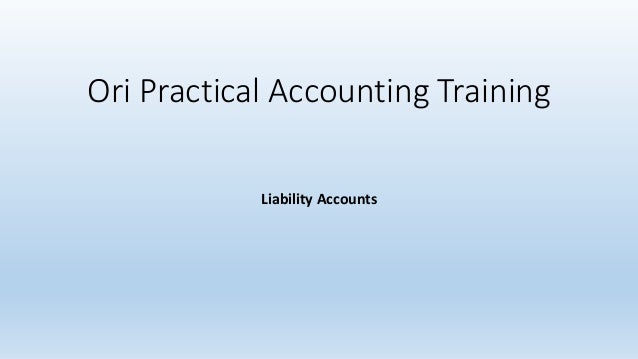Ori Practical Accounting Training_FA_Module 7 Liabilities.pptx
•Download as PPTX, PDF•
0 likes•4 views
accounting principles
Report
Share
Report
Share

Recommended
More Related Content
Featured
Featured (20)
Product Design Trends in 2024 | Teenage Engineerings

Product Design Trends in 2024 | Teenage Engineerings
How Race, Age and Gender Shape Attitudes Towards Mental Health

How Race, Age and Gender Shape Attitudes Towards Mental Health
AI Trends in Creative Operations 2024 by Artwork Flow.pdf

AI Trends in Creative Operations 2024 by Artwork Flow.pdf
Content Methodology: A Best Practices Report (Webinar)

Content Methodology: A Best Practices Report (Webinar)
How to Prepare For a Successful Job Search for 2024

How to Prepare For a Successful Job Search for 2024
Social Media Marketing Trends 2024 // The Global Indie Insights

Social Media Marketing Trends 2024 // The Global Indie Insights
Trends In Paid Search: Navigating The Digital Landscape In 2024

Trends In Paid Search: Navigating The Digital Landscape In 2024
5 Public speaking tips from TED - Visualized summary

5 Public speaking tips from TED - Visualized summary
Google's Just Not That Into You: Understanding Core Updates & Search Intent

Google's Just Not That Into You: Understanding Core Updates & Search Intent
The six step guide to practical project management

The six step guide to practical project management
Beginners Guide to TikTok for Search - Rachel Pearson - We are Tilt __ Bright...

Beginners Guide to TikTok for Search - Rachel Pearson - We are Tilt __ Bright...
Ori Practical Accounting Training_FA_Module 7 Liabilities.pptx
- 1. Ori Practical Accounting Training Liability Accounts
- 2. What is a Liability Account? – Definition • Liabilities are defined as debts owed to other companies. • In a sense, a liability is a creditor’s claim on a company’ assets. • In other words, the creditor has the right to confiscate assets from a company if the company doesn’t pay it debts
- 3. What is a Liability Account? – Definition • Debt financing is often used to fund operations or expansions. These debts usually arise from business transactions like purchases of goods and services, • Liability accounts have a credit balance. This means that entries created on the left side (debit entries) of a liability T-account decrease the liability account balance while journal entries created on the right side (credit entries) increase the account balance
- 4. Types of Liability Accounts – Examples • There are many different kinds of liability accounts, although most accounting systems groups these accounts into two main categories: current and non-current. • Current liabilities are debts that become due within the year, • while non-current liabilities are debts that become due greater than one year in the future
- 5. Current Liabilities • Accounts Payable – Many companies purchase inventory on credit from vendors or supplies. When the supplier delivers the inventory, the company usually has 30 days to pay for it • Accrued Expenses – Since accounting periods rarely fall directly after an expense period, companies often incur expenses but don’t pay them until the next period. These expenses are called accrued liabilities. Take utilities for example
- 6. Non-current Liabilities • Bonds Payable – Many companies choose to issue bonds to the public in order to finance future growth. Bonds are essentially contracts to pay the bondholders the face amount plus interest on the maturity date. Bonds are almost always long-term liabilities. • Notes Payable – A note payable is a long-term contract to borrow money from a creditor. The most common notes payable are mortgages and personal notes. • Unearned Revenue – Unearned revenue is slightly different from other liabilities because it doesn’t involve direct borrowing. • Unearned revenue arises when a company sells goods or services to a customer who pays the company but doesn’t receive the goods or services. In effect, this customer paid in advance for is purchase. • The company must recognize a liability because it owes the customer for the goods or services the customer paid for.
